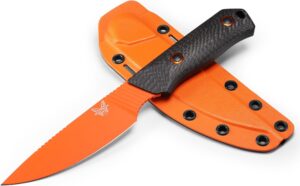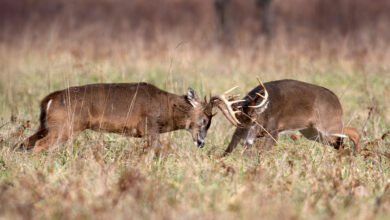The Top 9 Best Hunting Knives for All of Your Hunting Needs

To be honest, most hunters give more importance to their rifles than to their knives. At times, I have been guilty of such behavior myself.
In reality, a hunting knife is a crucial tool that has been supporting humans since prehistoric times. Once you have hit the target, the right hunting knife makes the rest of the task a lot easier.
So, what are some of the best hunting knives you can choose?
In this article, we discuss the 9 top hunting knives that offer the right mix of versatility and robustness for processing game.
How We Tested
After using hunting knives for almost two decades, I have a good field experience with some of the best hunting knife brands. This review started with scanning the market for the latest offerings and checking the preferences of our in-house team and experienced hunters in various forums.
After selecting fifteen of the top products, we started with a close inspection of the build quality and craftsmanship. In the next stage, we put them through a series of real-world tests, starting with a turkey hunting trip in South Texas. The primary testing activity was skinning and cutting meat to judge the strength and weaknesses of the blade, as well as the ergonomics. Finally, we checked the quality and design of the sheaths for any flaws.
Honestly, with so many knives around, things did get a bit messy at times. Choosing some of these products over the others was not easy either. In the end, based on our rigorous tests, these 9 options stood out from the rest.
1. Benchmade Raghorn
Best Overall
Without a doubt, the Raghorn is one of the top products among Benchmade’s range of hunting knives. One thing I like about the Oregon-based company is the solid reliability of their products, and the Raghorn is no exception.
The orange-coated blade looks gorgeous and is made from CPM CRU-WEAR steel. This carbon steel is not only tough, but also has great edge retention. I have used this blade to cut through an elk sternum, and it never felt inadequate.
The 4-inch drop-point blade weighs 1.67 oz, making the Raghorn incredibly light. The carbon fibre handle is well-designed and makes it even more attractive.
I’ve got to admit, the Raghorn feels incredibly comfortable in the hand while dressing an animal. In addition to the grippy handle, there is jimping on the spine and texture on the sides for pinch gripping. The jimping is thoughtfully carved, and you can place your fingers on the blade to use the knife with surgical precision.
This knife can work through big game animals and still retain its sharpness. Wipe it down, and the Raghorn is ready for regular cutting tasks around the campfire.
So, is the Raghorn worth the premium price tag?
Yes, absolutely. I wouldn’t hesitate to recommend this blade to anyone looking for an all-rounder for the next hunting season.
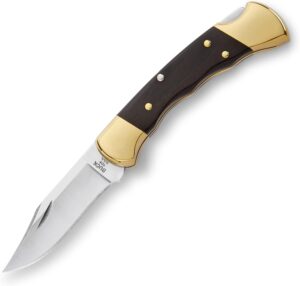
2. Buck Ranger 112
Best Pocket Knife
To be honest, the Buck Ranger 112 didn’t win my appreciation when I picked it up for the first time. But after carrying it for a few days, the old school charm worked, and it has become one of my favourite hard-use knives.
The 112 is the smaller version of the classic Buck 110, and comes with the traditional ebony hardwood handle and brass bolsters. The overall ergonomics is great, and I got no hot spots after long periods of use. The grip is rock solid, and even with no textures, I never had any issues with slippage.
The satin-finished clip point blade is made of 420HC stainless steel and retains an edge very well. I spoke to hunters who have abused this blade for years, and they confirmed that all this blade needs to stay wickedly sharp is a little bit of resharpening.
One thing is, the blade can’t be opened and closed with one hand. So, this isn’t a folding knife with easy deployment. However, this is a versatile knife that you can depend on for a wide range of activities.
Make no mistake about it, the Ranger 112 is not a regular pocket knife for everyday carry. But if you’re looking for a heavy-duty hunting pocket knife, this is it.
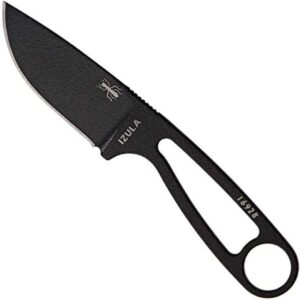
3. ESEE Izula
Most Versatile
Named after the fierce Bullet ant of Peru, the Izula is a deceptive hunting knife. At first glance, the 2.63-inch blade may seem too small. But know this: this blade can punch above its weight. And there is something about the simple design that makes it stand out.
To start with, the powder-coated 1095 high-carbon blade is a chunky piece of steel that can handle heavy tasks. The handle design and the jimping on the spine give you a solid grip. This is a stronger knife than most pocket knives, and small enough to be carried in a pocket. The quality of the sheath is good, and there is no wiggle while carrying it around.
Despite its bare-bones look, the Izula’s high-quality drop point blade never lets you down. I have used the knife for a few tough cutting tasks, and it never felt close to breaking point. Considering the lightweight build, the Izula is extremely well balanced. The fit and finish are top-notch as well.
That said, the ergonomics are limited. The sharp edges of the handle can cut into your hands after prolonged skinning tasks, especially while applying lateral pressure. Wrapping it up with some paracord is a good idea.
To sum it up, ESEE has combined a utilitarian blade with excellent cutting performance. At this price, the Izula offers excellent value and will perfectly suit the versatile needs of an outdoorsman.
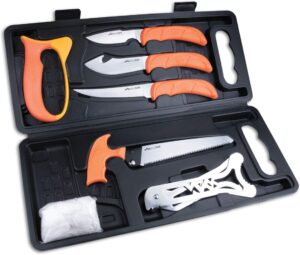
4. Outdoor Edge WildPak 8-Piece Hunting Knife Set
Best Budget Hunting Knife
This 8-piece “field to freezer” knife set comes in a hard cover case and is a comprehensive kit at an affordable price tag. Made from 420J2 stainless steel, the blades are hand finished to ensure a precise 22-degree edge.
I have used these blades roughly, without trying to preserve the edge. The blades are strong, especially the caping knife and boning knife. They work well for skinning game and cutting through tough materials.
The boning saw is a useful addition and is great for managing various tasks in a camp. The rib cage spreader is another invaluable tool for processing elk. Out of the box, the blades are not so sharp. I usually sharpen them with the provided sharpener before heading out, and they retain sharpness fairly well.
The TPR handles are ergonomically designed and offer a great grip. Even so, TPR has its limitations, and I wouldn’t recommend exposing these knives to extreme temperatures. Now, the quality of the included gloves is not so good. But at this price point, I wouldn’t consider it to be much of a con.
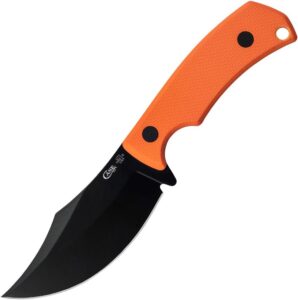
5. Case CT3 Hunter
Best Ergonomics
This fixed knife from Case isn’t just a hunting knife, but can come in handy for a whole range of outdoor activities. The 3.94-inch blade is made from 1095 carbon steel and has a fully exposed tang. The steel is not just super tough, but is also easy to resharpen.
Ergonomics is an extremely important aspect for a ‘skinner’ type of knife, and the CT3 scores high in this regard. The texture on the handle is perfect. It’s not too aggressive, but it offers the right grip. I love the way my index finger fits into the groove at the top of the handle, allowing me to have more control.
The handle is over 4 inches long, and even with big hands, there is enough space for getting a comfortable grip. I used the blade to make fine cuts and pinch gripped it for precision. There were no hot spots at any point during the use. The CT3 is an extremely well-balanced knife, and there is hardly any hand fatigue after prolonged use.
The handle, made from G10 composite material, has excellent durability and weather resistance. One downside of G10 is that it may feel slippery when wet. But I never faced such issues while using the CT3.
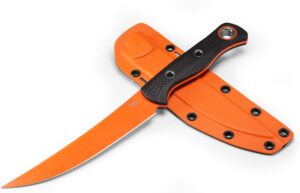
6. Benchmade MeatCrafter
Best for Butchering
The MeatCrafter is another Benchmade product that offers excellent dependability during real-world field use. Right from the point of unboxing, I noticed that the edge of this knife was crazy sharp – it’s definitely one of the sharpest hunting knives I have used.
Perhaps that has something to do with the SelectEdge technology that Benchmade uses. If you’re planning to use this knife as a kitchen arsenal, be careful with your fingers.
The tip is great for cutting, but I find the 6-inch blade a bit too long for tasks like precision skinning. However, the sharpness of the CPM-S45VN satin-finish blade comes in handy while breaking down an animal carcass into smaller pieces of meat by cutting through thick muscle. I have also found the MeatCrafter to be a great fillet knife in the kitchen.
The material has a 60- 62HRC hardness grade, and you can expect excellent performance for extended periods. As expected, Benchmade has done a stellar job with the ergonomics. The handle is comfortable to grip, and the carbon fibre material offers a great feel.
Again, the MeatCrafter comes with a premium price tag. But if you want a deer knife built for processing and that will last for a lifetime, the MeatCrafter ticks all the right boxes.
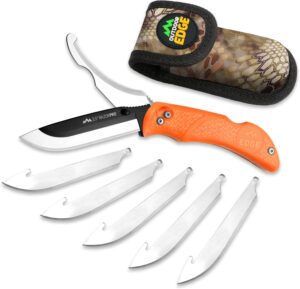
7. Outdoor Edge RazorPro
I have used the RazorPro for over three years, and it remains one of the go-to options for handling the messiest of field tasks. If you think that replaceable blade knives are flimsy, you’ll change your view after handling the RazorPro.
The 3.5-inch blade is made from 420J2 stainless steel and is razor sharp. The blade holder is robust, and even with tough cutting tasks, the blade never felt anything less than super sturdy. The ergonomics of the rubberized TPR handle with a no-slip grip are spot on.
At 8.3 oz, this isn’t a lightweight deer skinning knife. But the addition of the secondary fold-out gutting blade makes it the perfect field dressing tool. The shape of the blade ensures that you will not cut into the animal’s abdominal cavity. I found the blade great for cleaning antlers after a day of shed hunting as well.
Plus, you get six replacement blades with the knife, which makes this a fantastic deal at a reasonable price point. Replacing a blade is super easy and can be done by pushing the blade release button. That said, there is one downside. The groove that holds the blade is hard to clean.

8. Kershaw Deschutes Skinner
The Kershaw Skinner has a no-nonsense look and a design that offers great versatility. If you want a functional deer knife at a reasonable price, the Skiner is worth checking out.
The 3.9-inch blade is on the thinner side, which gives it excellent slicing ability. The shape of the blade is perfect for making sweeping cuts while processing deer or birds. Admittedly, the D2 steel used in the blade is not the best grade in terms of sharpness. But it holds an edge for longer periods and is extremely resistant to wear.
I have used this blade on a few turkeys and nicked bones with it. But it remains sharp enough without the need for a touch-up. The polypropylene handle is contoured to offer a good grip, and while it isn’t the most comfortable option, it fits in my hand really well.
There are two spots on the blade with jimping for better blade control. In addition, the blade has a finger choil that allows you to improve precision. Note that this does reduce blade real estate to some extent. Keep in mind that this is a full-tang knife, though the handle covers it up.

9. Gerber Gear StrongArm
One of the most popular knives from Gerber Gear, the StrongArm fits perfectly into the zone overlapping hunting and camping knives. In my experience, this is a fixed blade knife that will keep performing even if you push it to the limits.
The overall balance and handling of the knife are top-notch, making it great for cutting tasks. The 4.8-inch 420 HC stainless steel blade can take abuse, but you will need to sharpen it before a field dressing activity. With the right sharpening techniques, the blade can get wickedly sharp and separate ball joints with ease. Plus, it holds up well even after being used for tasks like chopping and batoning.
A rubberised diamond-textured grip runs around the full tang blade and gives a solid in-hand feel. Even though this is a bulky knife, the well-designed sheath makes it easy to carry. In truth, the modular design of the sheath is a big plus of the StrongArm.
Note that the StrongArm isn’t a hunting knife built for precision. Nor does its military design make it look like one. Even so, if you are looking for a crossover knife that will be an all-around companion, it’s a solid option.
How to Choose the Best Hunting Knife
When choosing a knife for hunting, you need to know exactly what the knife will be used for. The point I want to make is, there are knives designed for specific tasks, and then there are all-purpose knives. Once you know which blade works best for you, you can make the best choice. In addition, check the other factors mentioned below.
Size
A medium-sized blade measuring between 3 and 5 inches is what most hunters prefer. For me, a blade length of around 4 inches works best.
You may prefer a bigger blade, but keep in mind that carrying longer and heavier knives can be a cumbersome task during a long day of whitetail deer hunting. Moreover, a relatively small hunting knife will give you more control over the cutting process.
Steel Type
With modern metallurgy impacting the microstructure of steel in so many ways, there are a variety of steel options out there. In general, the blade steel should offer four main qualities: strength, toughness, edge retention, and ease of sharpening.
High carbon steel, like 1066 or 5160 steel, offers excellent toughness but has low corrosion resistance. D2 steel is another option that is tough and can hold a sharp edge as well. S30V and VG-10 stainless steel offer a great balance of corrosion resistance, edge retention, and toughness.
Blade Shape
Most hunting knives come with a clip or drop point blade. The drop point blade has a sloped curve on the spine that makes it great for gutting and skinning tasks. These blades also deliver a strong cutting action needed for quartering big game.
The clip point blade has a thinner point, and the spine drops towards the tip at a more abrupt angle. This results in a pointier tip that works great for tasks like skinning. Beyond that, there are boning blades that are great for separating the flesh from the bones and for cleaning birds after a day of pheasant hunting.
As a pro tip, I’d suggest going for a full-tang hunting knife as they offer more durability.
Fixed or Replaceable Blade
The classic fixed-blade hunting knives have been around for a long time, and they remain a favorite choice for most hunters. But you can’t ignore the advantages of replaceable blade knives. Firstly, the scalpel-type blades are sharper than most fixed-blade knives. Besides, replacing blades on the field is easier than sharpening them.
That said, fixed blades have more durable edges, and they retain their edges for a longer period. Moreover, carelessly disposed of blades in the wilderness can be a danger to animals and also to other people.
Handles
Since you will be using a hunting knife for longer periods, a grippy and comfortable handle is essential to ensure safety. There is a wide variety of knife handles available in the market, including natural and synthetic materials. Choose a handle that offers solid durability and enough grip to prevent the knife from slipping, especially while working with wet hands.
Price and Value
While premium-grade hunting knives can be expensive, some knives offer good quality at reasonable prices. The thing is, compromising on the price and ending up with an inferior product is not the right option.
Undoubtedly, a superior blade and ergonomic design have their advantages while skinning big-game animals. But that doesn’t mean that a solidly built knife with a cheaper price tag will give you major issues.
The Best Hunting Knives: FAQs
How do I sharpen a hunting knife?
The best way to sharpen a knife in the field is to use a field sharpener that is easy to use and small enough to stash in the pocket.
How do I care for and clean a hunting knife?
It is necessary to thoroughly clean and dry the knife after every use. In addition, lubricate the joints and pivots to reduce friction.
Can I carry a hunting knife on my belt?
Carrying a knife on your belt or any other form of open carry is allowed in most states. However, check your state’s knife law to be sure.
What is the best knife shape to use for deer hunting?
For most deer hunters, a drop-point blade is the go-to choice. It offers the right level of cutting force and control as a deer skinning knife.
Final Thoughts
Even though hunting knives are not complex or sensitive devices like range finders or hunting binoculars, selecting the right option requires a fair bit of consideration. This list of knives for hunting includes our favorite choices in terms of practicality and durability.
Quite simply, an inferior piece of steel will leave you ill-equipped in the field. Remember, the hard work begins after you have made the shot. That is when one of these knives could be the perfect tool for you.

